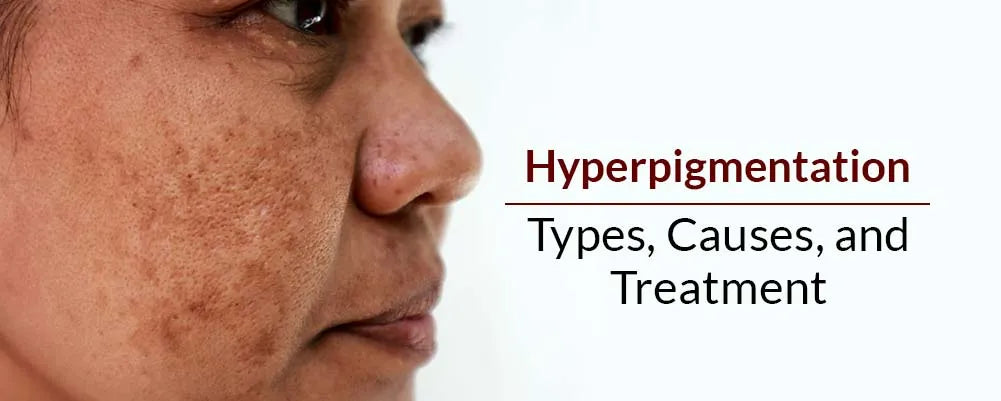Hyperpigmentation: Types, causes, and treatment

Hyperpigmentation is one of the most ignored skin issues. Most of us either don’t see the signs of it or we think it can’t be cured. But ignoring always makes any issue stubborn and untreatable. Let’s first know all about Hyperpigmentation.
Hyper means “more” and pigment means “color”. The term hyperpigmentation is used to describe unevenly pigmented areas of the skin. This common condition of the skin results in some skin areas being more pigmented than other skin areas, darkened patches that vary in size and color. The color can appear light to dark brown, grey, red, pink, or black spots and patches on the skin. These spots are also known as liver spots, sun spots, or age spots. These spots can occur all over or in just one area of the body.
Types of Hyperpigmentation:
- Melasma:
One explicit sort of hyperpigmentation is melasma, a condition that affects a lot of people. Melasma is a common acquired skin disorder that presents as a blotchy, light-to-dark brown facial pigmentation. It is not generally caused due to sun exposure, by also hormonal changes inside the body. Melasma results in dark and dull patches of skin on an individual's cheeks, upper lip, jaw, nose, or other cranial skin areas. Melasma mostly occurs in pregnant women and women have side effects due to some kind of oral contraceptives.
- Age and sun spots:
Pigment spots, also known as sun spots are caused by prolonged sun exposure. These spots generally appear on the face and mainly on body parts that are most exposed to the sun such as the face, hands, shoulders, neck, and arms. They are flat, small, and darkened patches on the skin. They vary in size. Age spots are very common in adults older than 50, but younger people can get them if they spend time in the sun and are most common in adults with light skin.
- Post-inflammatory hyperpigmentation:
People who earlier have active acne, generally experience post-inflammatory hyperpigmentation. This type of hyperpigmentation occurs when acne or skin injury heals and leaves a mark and uneven skin tone or discoloration behind after healing.
What is the main reason for hyperpigmentation?
Our skin gets its color of the skin from a substance, known as melanin, made by the skin cells. It is basically a natural pigment that gives our skin, eyes, and hair the color they have. When these skin cells are triggered or are damaged, they produce more melanin in the skin, resulting in darkened patches on the skin
Factors that lead to hyperpigmentation:
- Hormonal changes
- Sun exposure
- Skin injuries and inflammation
- Medication
- Pregnancy
- Thyroid disorders.
- Not getting enough vitamins, such as B12 and folic acid.
How do you get rid of hyperpigmentation?
The appearance of hyperpigmentation can make you feel self-conscious. Hyperpigmentation can’t always be prevented but protecting the skin from the sun damage caused by the ultraviolet helps, and using the best treatment for hyperpigmentation can help a lot.
- Protect the skin from sun damage:
It is a necessity to give your skin the sun protection it needs daily. Applying broad-spectrum sun protection every day before sun exposure is the first step you can take in helping to prevent hyperpigmentation. Not only on sunny days but even on monsoon and cold days, it is important to use sunscreen as the harmful UV radiations of the sun can affect the skin when the sun is barely visible. Re-applied religiously every after 2 hours.
Also, wear protective clothing and try to avoid prolonged sun exposure.
- Topical Treatment:
Adding a topical cream to your skincare routine to treat hyperpigmentation, melasma, and scars can be beneficial for a person. The most successful formulation for these issues has been a combination of Tranexamic Acid and, Kojic Acid, which helps in treating the skin from melasma and hyperpigmentation without thinning the upper layer and making it sensitive to the sun.
Fixderma’s recommendation in the topical melasma and hyperpigmentation treatment is the uniquely formulated Skarfix- TX and Skarfix-Plus. This is the best hyperpigmentation treatment, as it contains skin-loving actives like Kojic acid, Alpha Arbutin, Tranexamic Acid, and Vitamin E that is non-steroidal, works on all types of pigmentation, and exfoliates the targeted darkened skin.
Just be patient with any treatments you’re trying, as they can take months to show improvement
(Do a patch test first on the back of your arm or behind your ear. Do not forget to apply sunscreen in the morning)








